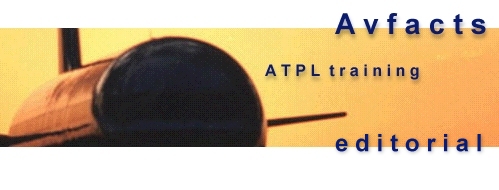General
There are times when it is a good idea to climb to a higher altitude
whilst enroute. This could be to get an increased tail wind/decreased head
wind, to reduce the fuel flow, or to escape from turbulence. Either way, the
new flight level you wish to cruise at may not be available immediately, and
you may have to delay the step climb until the aircraft GW is reduced to a
suitable level.
We will be referencing page 2-14 of the B727 manual when undertaking step
climb calculations.
 |
Points to remember:
- Manual page 2-2a, para 2 states that an abbreviated method to be
used in step climb calculations is to allow 50 kg/1, 000 ft of
step climb to account for the extra fuel burnt in the climb. No
distance need be calculated for the step climb zone. (ie: the
aircraft is suddenly at the new level having burnt 50 kg of fuel
per thousand feet. No climb time need be allowed for either.
- A step climb is different from a “drift climb” technique in
that the step climb is deliberately delayed until the point when a
climb can be made directly to the new level at climb speed (Mach
0.78) at climb thrust. A drift climb occurs at cruise power, and
cruise speed.
- These are usually stand alone questions in ATPL exams, though
you may incorporate them in a large normal operations flight plan
if you feel it would reduce the total flight fuel.
|
Example 1.
A B727 is tracking from Auckland (New Zealand) to Hobart on ERC H5 route
L513. At TopC (150 DME Auckland) FL310 the aircraft begins to cruise at Mach
0.80 at a gross weight of 75, 000 kg, in ISA +10 conditions. The wind is 115
kt HEAD.
Turbulence begins to increase as a result of a forecast upper level
jetstream with a core centred at FL330.
The Captain wishes to climb into the smooth air reported at FL350 as soon
as possible.
Assuming the aircraft continues at Mach 0.80/FL310 until a climb to FL350
can be commenced, and that Mach 0.80 schedule will be used on reaching FL350
where the temperature is ISA +10, at what minimum distance past TopC can the
climb to FL350 be commenced ?


Points to note:
- A common mistake is to subtract the step climb fuel from the TopC GW
instead of adding it. This will almost definately mean a fail in this
case.
- Be aware of whether it is a head or tail wind. Another way to fail.
- When finding the TopC GW at the new level, remember to use the ISA
deviation/Mach number combination at the new level.
- If you are asked to step climb as soon as possible, and no cruise Mach
number for the new level is quoted, enter page 2-14 and extract the
cruise schedule that has the highest GW. This will reduce the fuel burn
off required, and in doing so shorten the distance to the start of climb
point. Typically M 0.79 will allow a step climb soonest, even sooner
than Long Range Cruise (LRC).
This training editorial is a sample taken from the remote
learning Flight Planning course developed by Rob Avery. It is available in
“Full Course” or “Limited Edition” formats, with delivery by paper
copy, or internet delivery. Package prices start at Aust $39.00. Click
here for more information.
 |
B727 Flight Planning Complete Course(Code Av7)
Texts from the nations leading ATPL course. Eclipses all
other Flight Planning courses with it’s easy to understand format.
Excellent first sit pass rates by students, with recent scores up to 100%.
No stone left unturned, plus ATPL Online Help provided.
All working/answers provided-no tedious correspondence
courses. If you are not using these texts, you are doing it too hard, and
paying too much. It’s that simple !
Buy
this course. |
 |
B727 Flight Planning Training Texts
Limited Edition (Code Av8)
These limited edition texts are designed for those pilots
finding difficulty passing the CASA examination. They cover all types of
operation, both normal and abnormal.Over 60 worked CASA style questions,
and featuring handy tips to save time in the exam.
111 pages. Ideally, read in association with B727 “Flight
Planning Practice Examination” booklet (Ref Av3).
Buy this book. |
 |
B727 Flight Planning Practice Exams (Code
Av3)
A must for anyone sitting this difficult
and time limited exam. There are 5 fully worked exams, each with 50 marks
as in the CASA exam. Marks shown are similar those in CASA exam.
If you do NOT have this booklet, you are
risking precious marks.
Click
here for online sample exam questions.
Buy
this book. |










![]()